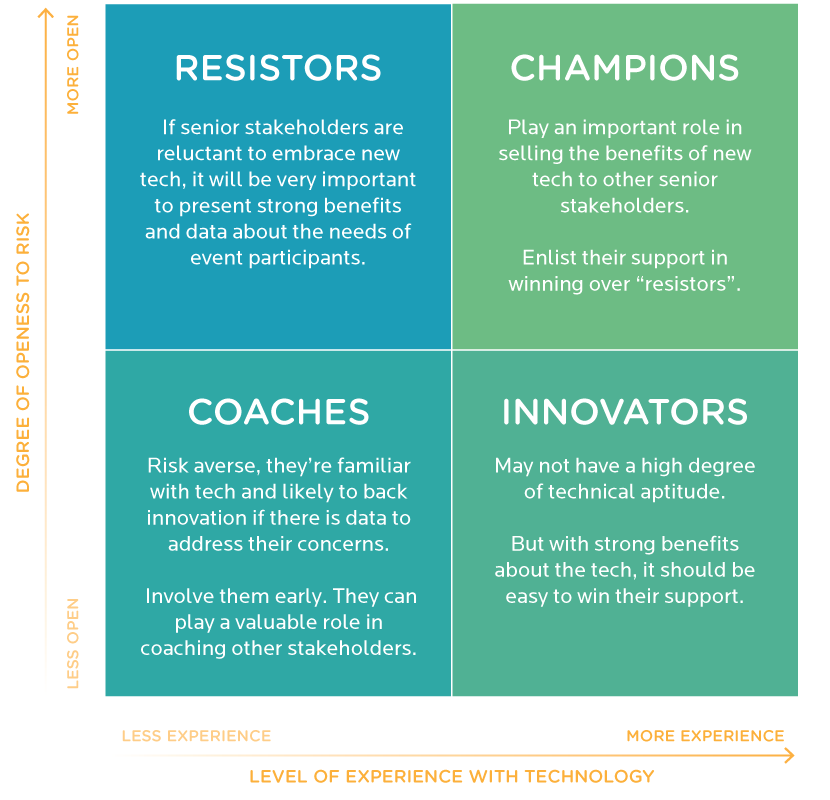7 Surefire Strategies for Selling Through Event Technology to your Executives
So you’re enthusiastic about introducing event technology for your next event. Whether you are an internal event planner or an independent meeting planner working on behalf of a client, it’s important to hit the pause button.
I learned this lesson years ago when working for a wireless communications firm.
The approach to one of the management development programs I had been asked to take over was staid and boring. So, I burned the candle at both ends and did a complete makeover. The changes were received enthusiastically….except for the first time I ran the new version. Shortly after the program started, it was clear that the group was not warming up to the interactive exercises and colorful props and decorations that I had added to reinforce the theme.
I called an unscheduled break, placed all of the props on a side table, and checked in with the group before continuing. This was a group of veteran managers and directors who preferred a traditional approach to learning. So, for this group, I reverted to the old version of the program.
There were a number of takeaways from that experience that I have never forgotten. The first and most important lesson was “know your audience”. This is directly relevant to pitching innovative new technology to senior stakeholders.
1. Know your audience.
When you’re introducing event technology, remember there are at least two audiences:
- Senior stakeholders with the power to make go/no-go decisions about new technology
- Event participants
Often, senior stakeholders and participants are from different demographic or psychographic groups. Their perceptions of technology may not be in sync. It’s not just a matter of age. It has to do with the level; of comfort level in using technology and adaptability to technological innovations.
Here’s a simple grid you can use to determine the most effective strategies to sell through technology to senior stakeholders.
- Take the time to find out how much experience senior stakeholders and event participants have with the technology you want to introduce.
- You can obtain this information by speaking with executive assistants, individual interviews, mini-surveys, and focus groups.
- Next, create a profile for each senior stakeholder to capture the information you collect.
- Design your strategy for engaging senior stakeholders based on your assessment of the technical aptitude of stakeholders and their level of comfort with risk.
2. Benchmark with the best.
Benchmarking is an important step in winning the support of senior stakeholders. Identify companies and industries that senior executives in your organization or client organization consider to be best-in-class, who are already using the event technology you want to introduce.
How can you uncover this information? Follow the steps in #1. Add a question about which organizations and executives are viewed as innovators or champions. Also, pay attention to the examples that senior stakeholders use in their own presentations. Reach out to these organizations and compare notes.
3. Do your homework.
Identify:
- Events that are similar to the events you are planning
- The technology that is used at these events
- Success stories and best practices
- Pitfalls to avoid
Fortunately, we live in an age in which the process of researching examples, articles, blog posts, and videos has been simplified.
4. Pinpoint the benefits.
Benefits must be clear, specific and quantifiable. If you’re asking an senior executive to approve an investment in new technology, definitely be sure to clearly articulate benefits and provide specific examples as back up.
For example, if you are trying to sell through an event app to senior stakeholders, strong benefits might include cost savings, streamlining communication, removing bottlenecks, and timely transmission of important information to participants, speakers, sponsors, and exhibitors. If there are a long list of benefits, it can’t hurt to lead with the one your executives perceive to solve the most “painful” pain point.
5. Research all associated costs.
A “no surprises” approach works best when introducing new technology. This is particularly important if there has been some resistance and it has taken time to win support for new technological initiatives.
6. Build and present your business case.
It must be tight, targeted, and concise. Provide an opportunity for questions. Include facts and figures but, remember, examples and anecdotes from respected sources can be a powerful way of building support. Identify possible concerns and objections and provide information to address them.
Here is a suggested outline to help you cover all the bases with supporting data when building a business case. Wrap up by repeating the proposed solution and call to action.
This is a modified version of the model developed by Gilmore and Associates, founded by the late Blake Gilmore:
- Challenge or Opportunity
- Proposed Solution or Approach (technology you are recommending)
- Benefits
- Credentials (what qualifies you to make this recommendation. Here you can include a brief overview of the process you took to arrive at the solution)
- Short agenda
- Call-to-action
7. Book a demo.
- Arrange for a customized demo to take place during an executive meeting
- Take advantage of trade shows with executive forums (example: Executive Meeting Forum at IMEX
Sometimes it can take time to convince senior stakeholders of the value of introducing new event technology. The time invested will pay-off when your suggestions and accepted and implemented.
What’s Next?
- Ready to make the business case for an event app? Check out our ebook: The Ultimate Guide to Event App Sponsorship, and find out how to generate more value out of your event tech investment.
- Drones, VR, AR, oh my! Looking for ideas on integrating the latest and greatest technology into your next event? Read our post: 8 Keys to Integrating Emerging Technology into Events
